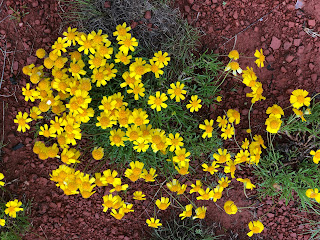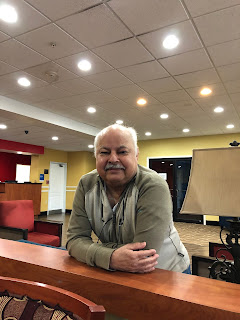 The National Route 66 Museum has its exhibits arranged as tableau showing the development of the Road as part of social history through the decades. It also had the explanation for the deep red soil of Oklahoma, which is barite. The crystal formations are known as "roses". Oklahoma has the richest source of barite in the world. Erosion of the red rocks forms the sandy red soil of the state.
The National Route 66 Museum has its exhibits arranged as tableau showing the development of the Road as part of social history through the decades. It also had the explanation for the deep red soil of Oklahoma, which is barite. The crystal formations are known as "roses". Oklahoma has the richest source of barite in the world. Erosion of the red rocks forms the sandy red soil of the state.
 |
| Super Popeye collection. |
 |
| This car shows why drive-in movies were a lot more comfortable than one might imagine. |
 |
| Indian Motor Bike. Note the front ornament. |
 |
| An Electra Glide in blue |
 |
| The Road in the late 30s - 40s, when servicemen would hitch rides across the states |
 |
| A recreation of the famous Rattle Snake zoo , one of the many attractions built to entice passing motorists |
 |
| A bitter western rubberweed |
 |
| This is a small carnivorous plant of the species pinguicula or butterwort. not yet in bloom - which is pretty impressive identification off the top of my head |

More evidence of the changing landscape - a yucca plant and the beginning of western themed signage .
Between the ghost towns of Hext and Erick there is a section of the original road built of Portland cement, laid in blocks. The museum in Elk City had a Cadillac in which you could sit and watch a film as if you were driving the road.. So I recorded my own, not as well, but you can hear the regular "kerthump" every few seconds as the car travels over the joins in the concrete slabs. Children - do not try this yourselves. Luckily, there are no cops on 66.
This is the last place in Oklahoma - the Tumbleweed Cafe and Grill - and gift shop - in Texacola. It is run by Masel, who is also an accomplished artist in acrylics. This is her picture of Wild Bill Hicock. Here I am with Masel and her friend, Eddy. Happens that all four of us are 66, so this picture adds up to 264. Texacola is so-named because the border between the two states was constantly shifting, so they hedged their bets. It has a population of 35, as someone died last week. Texacola lies on the 100th Meridian, which is why they have a signature in their guest book from someone who lives in Taiwan. Except that Taiwan isn't on the 100th Meridian - it is on 121st. But I guess if you travel to the opposite side of the world, it is close enough.
T

 Route 66 is also known as the Will Rogers Highway as this famous singer cowboy lived in Oklahoma and travelled the old cattle trail that preceded it. Although the designation was proposed in 1935, it was not adopted by the US 66 Historical Association until 1952.
Route 66 is also known as the Will Rogers Highway as this famous singer cowboy lived in Oklahoma and travelled the old cattle trail that preceded it. Although the designation was proposed in 1935, it was not adopted by the US 66 Historical Association until 1952.
The first town in Texas, Shamrock. was founded in the 19th century by guess who? An Irish immigrant, and they can't quite get over it.

Elvis is in the building and sat in this booth.
The Main Street of McLean seems untouched since it was found in 1902 by Alfred Lowe.
Lowe was an Englishman from a wealthy family who came out west to invest in ranching, and established the RO Ranch about five miles south of the town. In 1901, he returned to England and married a cousin of Charles Kingsley, author of "The Water Babies", the novel that highlighted the plight of the Victorian child chimney-sweepers. He returned to live permanently in England in 1910, but he returned yearly to the ranch. He booked passage on the fated Titanic in 1912, and, refusing to enter a lifeboat, died of exposure in the freezing waters when the Titanic sank, in spite of being a strong swimmer.
McLean also has the first Phillips 66 gas staion in Texas, now restored, and this splendid motel sign.
West of McLean, the land becomes more arid and the vegetation changes. The Road also disappears into the famous "Jericho Gap" which was notorious for its muddy conditions - and still is. Best avoided, although it means a short spell on the Interstate into Groom.
Amarillo is the first major town and where I stopped that night.



















No comments:
Post a Comment